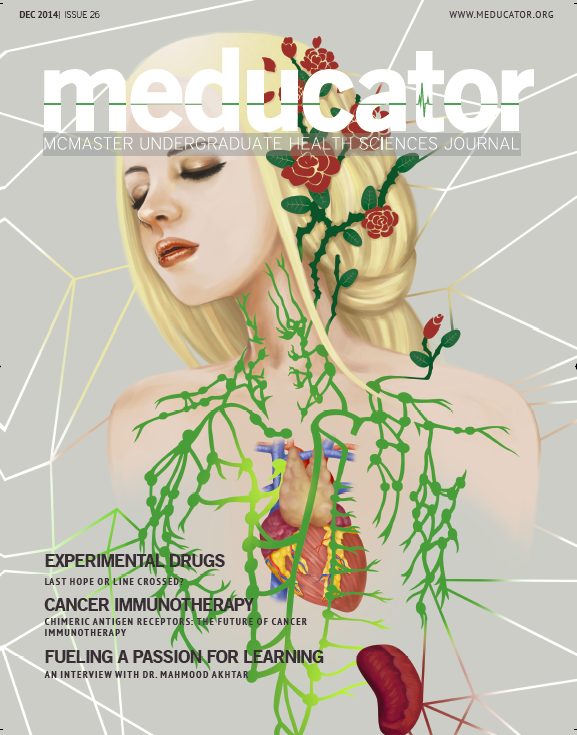Chimeric Antigen Receptors: The Future of Cancer Immunotherapy
DOI:
https://doi.org/10.15173/m.v1i26.948Abstract
Chemotherapy, radiation therapy, and surgery are currently the most widely
used cancer treatment modalities. Although these therapies have successfully
been used to treat various cancers, they are accompanied by significant
limitations. Cancer immunotherapy, an emerging field of study named the
breakthrough of the year in 2013 is offering hope for an era of new anticancer
modalities.1 In addition to serving as a safeguard against infectious
disease, the immune system also prevents and delays tumour development..
Scientists have developed various immunotherapeutic treatments, each
targeting different aspects of the immune system. One therapy involves
genetically engineering T lymphocytes with chimeric antigen receptors (CARs)
that enhance the ability of T-cells to recognize and eliminate cancer cells. CART-
cell therapy has been highly effective in several clinical trials, eliminating
detectable tumour mass in several patients with B-cell malignancies and
solid tumours.2 This article will provide background into the field of cancer
immunotherapy, the structure and function of CARs, and recent developments
in CAR-T-cell therapy.
References
Couzin-Frankel J. Cancer Immunotherapy. Science.
Dec 20;342(6165):1432–3.
Barrett DM, Singh N, Porter DL, Grupp SA, June
CH. Chimeric Antigen Receptor Therapy for Cancer.
Annu Rev Med. 2014;65(1):333–47.
Sudhakar A. History of Cancer, Ancient and
Modern Treatment Methods. J Cancer Sci Ther.
;01(02):i–iv.
McCarthy EF. The Toxins of William B. Coley and
the Treatment of Bone and Soft-Tissue Sarcomas.
Iowa Orthop J. 2006;26:154–8.
Weiner LM, Dhodapkar MV, Ferrone S. Monoclonalantibodies for cancer immunotherapy. Lancet.
Mar 21;373(9668):1033–40.
Tagawa M. Cytokine therapy for cancer. Curr
Pharm Des. 2000 Apr;6(6):681–99.
Grupp SA, June CH. Adoptive cellular therapy.
Curr Top Microbiol Immunol. 2011;344:149–72.
Cheadle EJ, Sheard V, Hombach AA, Chmielewski
M, Riet T, Berrevoets C, et al. Chimeric antigen receptors
for T-cell based therapy. Methods Mol Biol
Clifton NJ. 2012;907:645–66.
Han EQ, Li X, Wang C, Li T, Han S. Chimeric antigen
receptor-engineered T cells for cancer immu-
Jan 15;90(2):720–4.
Penn Ovarian Cancer Research Center Immunotherapy
Program.
Sadelain M, Brentjens R, Rivière I. The Basic Principles
of Chimeric Antigen Receptor Design. Cancer
Discov. 2013 Apr 1;3(4):388–98.
Eshhar Z, Waks T, Gross G, Schindler DG.
Specific activation and targeting of cytotoxic
lymphocytes through chimeric single chains
consisting of antibody-binding domains and the
gamma or zeta subunits of the immunoglobulin
and T-cell receptors. Proc Natl Acad Sci. 1993
Dotti G, Gottschalk S, Savoldo B, Brenner
MK. Design and development of therapies
using chimeric antigen receptorexpressing
T cells. Immunol Rev. 2014
Jan;257(1):107–26.
Ahmad ZA, Yeap SK, Ali AM, Ho WY,
Alitheen NBM, Hamid M. scFv Antibody:
Principles and Clinical Application.
J Immunol Res. 2012 Mar
;2012:e980250.
Hudecek M, Lupo-Stanghellini M-T, Kosasih
PL, Sommermeyer D, Jensen MC,
Rader C, et al. Receptor Affinity and
Extracellular Domain Modifications
Affect Tumor Recognition by ROR1-
Specific Chimeric Antigen Receptor
T Cells. Clin Cancer Res. 2013 Jun
;19(12):3153–64.
Savoldo B, Ramos CA, Liu E, Mims MP,
Keating MJ, Carrum G, et al. CD28 costimulation
improves expansion and persistence
of chimeric antigen receptor–
modified T cells in lymphoma patients. J
Clin Invest. 2011 May 2;121(5):1822–
Milone MC, Fish JD, Carpenito C, Carroll
RG, Binder GK, Teachey D, et al. Chimeric
Receptors Containing CD137 Signal
Transduction Domains Mediate Enhanced
Survival of T Cells and Increased
Antileukemic Efficacy In Vivo. Mol Ther.
Apr 21;17(8):1453–64.
Zhang Q, Li H, Yang J, Li L, Zhang B, Li
J, et al. Strategies to improve the clinical
performance of chimeric antigen receptor-
modified T cells for cancer. Curr Gene
Ther. 2013 Feb;13(1):65–70.
Hennecke J, Wiley DC. T Cell Receptor–
MHC Interactions up Close. Cell. 2001
Jan 12;104(1):1–4.
Drake CG, Jaffee E, Pardoll DM. Mechanisms
of immune evasion by tumors. Adv
Immunol. 2006;90:51–81.
Bubeník J. MHC class I down-regulation:
tumour escape from immune surveillance?
(review). Int J Oncol. 2004
Aug;25(2):487–91.
Ramos CA, Dotti G. Chimeric Antigen Receptor
(CAR)-Engineered Lymphocytes
for Cancer Therapy. Expert Opin Biol Ther.
Jul;11(7):855–73.
Porter DL, Levine BL, Kalos M, Bagg A,
June CH. Chimeric antigen receptormodified
T cells in chronic lymphoid
leukemia. N Engl J Med. 2011 Aug
;365(8):725–33.
Grupp SA, Kalos M, Barrett D, Aplenc R,
Porter DL, Rheingold SR, et al. Chimeric
antigen receptor-modified T cells for
acute lymphoid leukemia. N Engl J Med.
Apr 18;368(16):1509–18.
Kochenderfer JN, Dudley ME, Kassim SH,
Somerville RPT, Carpenter RO, Stetler-
Stevenson M, et al. Chemotherapy-Refractory
Diffuse Large B-Cell Lymphoma
and Indolent B-Cell Malignancies Can Be
Effectively Treated With Autologous T
Cells Expressing an Anti-CD19 Chimeric
Antigen Receptor. J Clin Oncol. 2014 Aug
;JCO.2014.56.2025.
Maus MV, Fraietta JA, Levine BL, Kalos
M, Zhao Y, June CH. Adoptive immunotherapy
for cancer or viruses. Annu Rev
Immunol. 2014;32:189–225.
Louis CU, Savoldo B, Dotti G, Pule M,
Yvon E, Myers GD, et al. Antitumor activity
and long-term fate of chimeric antigen
receptor–positive T cells in patients
with neuroblastoma. Blood. 2011 Dec
;118(23):6050–6.
Beatty GL, Haas AR, Maus MV, Torigian
DA, Soulen MC, Plesa G, et al. Mesothelin-
Specific Chimeric Antigen Receptor
mRNA-Engineered T Cells Induce
Antitumor Activity in Solid Malignancies.
Cancer Immunol Res. 2014 Feb
;2(2):112–20.
Urruticoechea A, Alemany R, Balart J,
Villanueva A, Viñals F, Capellá G. Recent
advances in cancer therapy: an overview.
Curr Pharm Des. 2010 Jan;16(1):3–10.
Zou W. Immunosuppressive networks in
the tumour environment and their therapeutic
relevance. Nat Rev Cancer. 2005
Apr;5(4):263–74.
Chen G, Emens LA. Chemoimmunotherapy:
reengineering tumor immunity.
Cancer Immunol Immunother CII. 2013
Feb;62(2):203–16.
notherapy: progress and challenges. J Hematol
OncolJ Hematol Oncol. 2013 Jul 8;6(1):47.


